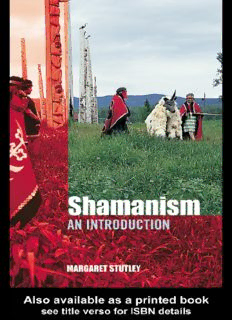Table Of ContentShamanism
Shamanism is one of the earliest and farthest-reaching magical and
religious traditions, vestiges of which still underlie the major religious
faiths of the modern world. The function of the shaman is to show his
or her people the unseen powers behind the mere appearances of
nature, as experienced through intuition, in trance states or during
ecstatic mystical visions. Shamans possess healing powers, communi-
cate with the dead and the world beyond and influence the weather
and movements of hunting animals. The psychological exaltation of
shamanic trance states is similar to the ecstasies of Yogis, Christian
mystics and Dervishes.
Shamanism: A Concise Introduction traces the development of
shamanism in its many fascinating global manifestations. Looking
at shamanic practices from Siberia to China and beyond, it provides
an accessible guide to one of the world’s most ancient, notorious
and frequently misrepresented spiritual traditions. Placing special
emphasis on the climatic, geographic and cultural pressures under
which shamanic customs arose and continue to be observed, Margaret
Stutley summarizes and clearly explains the logic of a faith whose
fantastical elements hold a special place in popular imagination.
Margaret Stutley is a leading scholar of world religions and folk
tradition, and is the author of several books including Hinduism(1989),
Ancient Indian Magic and Folklore(1980) and An Introduction to Magical
Elements in the Bible(1991).
Shamanism
An Introduction
Margaret Stutley
To Enys Davies, Christopher Aslet and
Emyr Owen Jones for all their
encouragement and help.
(cid:2)(cid:3)
First published 2003 by Routledge
11 New Fetter Lane, London EC4P 4EE
Simultaneously published in the USA and Canada
by Routledge
29 West 35th Street, New York, NY 10001
Routledge is an imprint of the Taylor & Francis Group
This edition published in the Taylor & Francis e-Library, 2004.
© 2003 Margaret Stutley
All rights reserved. No part of this book may be reprinted,
reproduced or utilized in any form or by any electronic,
mechanical, or other means, now known or hereafter
invented, including photocopying and recording, or in any
information storage or retrieval system, without permission
in writing from the publishers.
British Library Cataloguing in Publication Data
A catalogue record for this book is available from the British
Library
Library of Congress Cataloging in Publication Data
A catalog record for this book has been requested
ISBN 0-203-39816-5(cid:13)Master e-book ISBN
ISBN 0-203-39966-8(cid:13)(Adobe eReader Format)
ISBN 0–415–27317–X (hbk)
ISBN 0–415–27318–8 (pbk)
Contents
Acknowledgements ix
Introduction 1
1 Male and Female Shamans 6
The making of a shaman 7
Transvestism 10
Androgynous male and female shamans 12
Dragonfly shamans 15
Secret language 16
Visualization of one’s skeleton 18
Yakut shamans 19
Shamanic performances 20
Hungarian shamans 21
Chinese shamanesses 22
Korean shamanism 23
Evenki shamaness 23
Lapp shamanism 24
Shamans and smiths 25
2 Trance, Ecstasy and Possession 28
The ecstatic flight or journey 31
Descent to the underworld 34
Ecstatic religions 35
Forms of possession 37
VI CONTENTS
3 Shamans’ Paraphernalia 39
Drum decorations 41
Ket drum-making ceremony 44
Lapp, Sa¯mi and Tatar drums 45
Mirrors 46
Shaman’s staff 47
4 Deities and Spirits 49
Vairgitspirits 52
Tailaganceremony 54
Koryak spirits 55
Samoyed deity 56
Vogul deities and Khanty and Mansi spirits 56
Shadow spirits 57
Good and bad spirits 58
Yakut and Enet deities 59
Important female spirit 61
Khanty goddess, Vut-imi 61
Animal sacrifices 62
Chukchi ‘prayer paddle’ and Koryak whale festival 63
Tungus spirits and animals 63
Werewolves 65
Mongolian spirits 67
Womb goddess in the sky 68
5 The Shaman’s Costume 71
Shaman’s skeleton 74
Metal ornaments 76
Bird and animal images 77
A Tuva shamaness 79
Headgear 80
A Yukaghir and Chulym shaman 81
6 Divination and Healing 83
Divination 83
Healing 84
CONTENTS VII
7 Soul, Ancestor Cults and Death 94
Soul 94
Ainu underworld 99
Ancestor cults 99
Death and funeral rites 101
Death caused by women 105
8 Images and Idols 107
9 Were-Animals 111
Notes 113
Bibliography 120
Index 127
Acknowledgements
I should like to take this opportunity to thank the experts in the field
of shamanic studies for my extensive use of the following books:
U. Harva, Shamanic Costume and its Significance, Annales universitatis
fennicae aboensis (Turku) series B, 1 (2), 1922; M. Hoppál (ed.),
Shamanism in Eurasia, Göttingen, 1984, ‘Shamanism: An Archaic and/
or Recent System of Beliefs’, in Ural-Altic Yearbook, 57, pp. 121–140,
1985, with V. Diószegi, Shamanism in Siberia, Akadémiai Kiadó,
Budapest, 1978, and with A-L. Siikala, The Rite Technique of the Siberian
Shaman, F.F. Communications 220, Helsinki, 1978.
Margaret Stutley
Description:Shamanism traces the history, ideology and rites of the shamans' fascinating belief-system in its many global manifestations. Looking at the forms and functions of shamanic practices from Siberia to China and beyond, it provides an authoritative and accessible guide to some of the most notorious and

